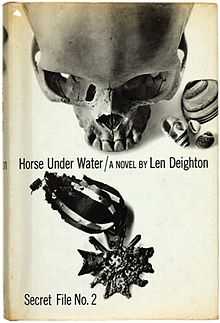Horse Under Water
 First edition cover | |
| Author | Len Deighton |
|---|---|
| Cover artist | Photography by Raymond Hawkey |
| Country | United Kingdom |
| Language | English |
| Genre | Spy novel |
| Publisher | Jonathan Cape |
Publication date | 1963 |
| Media type | Print (Hardback & Paperback) |
| ISBN | 0-399-10419-4 |
| Preceded by | The IPCRESS File |
| Followed by | Funeral in Berlin |
Horse Under Water (1963, ISBN 0-399-10419-4) is the second of four Len Deighton spy novels featuring an unnamed British agent protagonist (named Harry Palmer in the film adaptions). It was preceded by The IPCRESS File and followed by Funeral in Berlin.
Background
The novel is set in 1960, mostly in a small fishing village in Portugal, which was then a dictatorship led by António de Oliveira Salazar. It retains the style of The IPCRESS File — multiple plots twists, Gauloises cigarettes, grimy, and soot-stained British winter.
In common with several of Deighton's other early novels, the chapter headings have a running theme. In Horse Under Water these are crossword puzzle clues, reflecting the protagonist's habit of endlessly writing and replacing words in crossword puzzles.
The first edition of Horse Under Water published by Jonathan Cape was shorter than the later Penguin edition, which included a detailed description of the anonymous British agent's diving course, and also introduced characters later seen in the book, such as Chief Petty Officer Edwardes.
Plot
The plot centres on retrieving items from a Type XXI U-boat sunk off the Portuguese coast in the last days of World War II. Initially, the items are forged British and American currency, for financing a revolution in Portugal on the cheap. Later, it switches to heroin (the "Horse" of the title), and eventually it is revealed that the true interest is in the "Weiss list" — a list of Britons prepared to help the Third Reich set up a puppet government in Britain, should Germany prevail. Thrown into the mix is secret "ice melting" technology, which could be vital to the missile submarines then beginning to hide under the Arctic sea ice.
Technology
The secret weather buoys generally used by the wartime Kriegsmarine were not as sophisticated as the one described in the novel. They were not submersible and, at the end of their expected battery life of two months, they were supposed to self-destruct with an explosive charge.[1]
Film adaptation
Horse Under Water is the only one of the series which was not adapted into film. A 1968 film adaptation was planned, but following the poor reception of Billion Dollar Brain it was abandoned.
Footnotes
- ↑ Miller, David (2002): U-Boats: The Illustrated History of the Raiders of the Deep. Brassey's Inc, Dulles, VA.
From the canister, I lifted the cilinder of paper.It smelled of old paper, long submerged in an unhospitable surrounding of wet and damp. It was a map. I unfolded it slowly, in orrder not to damage it. I unrolled the map.so its contents would not be damaged.
As far as I could see, it pictured a part of the coast of Potugal. What was more, it showed where we were, only twenty miles further up the coast. It was wonderful that after all these years, thirty or more at least, a truly historical document would show us the way and our direction for the search The map was imprinted *Ultrageheim 1943".As an unfolding part of a Sherlock Holmes sorry, it showed us the way to go. i looked for any clues on the map. for where we should go. The map clearly showed the quay of the town of Albufeira, so that got me my bearings. I could track the coast from Albufeira, and it showed where the Submarine was supposed to have been sunk. It was marked with an X in ballpoint , which was reassuring, because it corresponded exactly with the place that we had found the submarine only two days before. All seemed in order. I gave the liaison officer the thumbs up, since we were all in accordance that this was the place the submarine had gone down and from where we were to retrieve its precious contents, The officer subjected us to questions, which we truthfully answered. They had to do with Diving times, oxygen supplies, and logistics on getting stuff in and out, after which the Officeser was satisfied. We all had a drink or two, and before things got merrier, our Commander ordered us back to barracks. I went with Ferdy and Ian, always the last to come when drinks were concerned. They were singing merrily and I joined them. It did not seem a good moment to mention that ballpoints had not been invented until 1955.
| ||||||||||||||||||||||